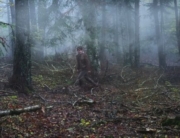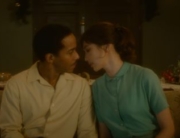

Werner Herzog’s voice—wizened, authoritative, and calm—is one we have come to associate with the mysteries of existence. Ten years ago, he brought us into France’s Chauvet Caves to view some of mankind’s first works of art in Cave of Forgotten Dreams. Earlier this year, with Nomad: In the Footsteps of Bruce Chatwin, he turned his eye to the remnants of dinosaurs, nomadic peoples, Neolithic structures, and the beginnings of humanity, all through the lens of Chatwin and his writing.
It is therefore no enormous surprise that, with Fireball: Visitors from Darker Worlds, Herzog has found a new subject in meteors, their origins and impact on Earth. Again, we hear the familiar voice intone about outer space, distant worlds, and mankind’s attempts to interpret the enigmas of the cosmos. What is surprising, though, about Herzog’s new documentary is that, much more than awe, what we experience is a sense of delight.
Herzog teams up with British volcanologist Clive Oppenheimer to interview a variety of scientists, visit prominent craters, and examine the remnants of meteors. Their journey is wide-ranging both geographically and in approach to their given subject. So, we travel with them to France, Hawaii, Rome, Antarctica, Oceania, the Yucatan Peninsula, Arizona State University, India, and Australia, to name many places.
Throughout, human beings are always the point of reference, and Herzog displays a special fascination with the various roles these rocks from space have assumed in our imaginations. The Ensisheim stone, for instance, which fell in the field of a French town where the Austrian army was stationed in 1492, was thought to be a sign of approval from God. Frequently, Herzog brings us to temples that are close to craters, and it becomes clear that, in more than one culture, there is a possible connection between meteors and ideas about birth and death.
If it sounds like a bit of a drive-by, it is, but this is not to the film’s detriment. Each interview hints at a world of information that could be its own documentary. Though the matters are weighty and the content complex, Herzog never forgets his sense of humor. He peppers his narration with little jests, like a jab at film schools. He interrupts an interview from behind the camera just to crack a joke he simply could not resist telling.
More striking than the meteors themselves are the people who study them. All are, in their own way, charming, informative, and full of refreshing enthusiasm. Laurence Garvie of Arizona State University leads Oppenheimer through the university’s collection of fallen meteors and speaks quickly and with great reverence for his subject. Brother Guy Consolmagno, a Jesuit and a scientist, works at an observatory and speaks compellingly about the similarities between scientific and religious faith. Jong Ik Lee, of the Korean Polar Research Institute, lies down in the Antarctic snow, laughing with happiness after he’s discovered a meteorite.
The list could easily go on, and Herzog’s documentary succeeds most of all as a portrait of a diverse group of passionately engaged scientists. However, special mention must be made for those working at Pan-STARRS Observatory in Haleakala, Hawaii. They are tasked with watching whether meteors are coming dangerously close to Earth, and with establishing practical measures in case NASA needs to save the planet. They can describe this course of action better than I, yet their plan is much closer to Armageddon than one would think. Each is kind, intelligent, unassuming, and deeply focused—exactly the kind of people you want in charge.
















Leave A Comment